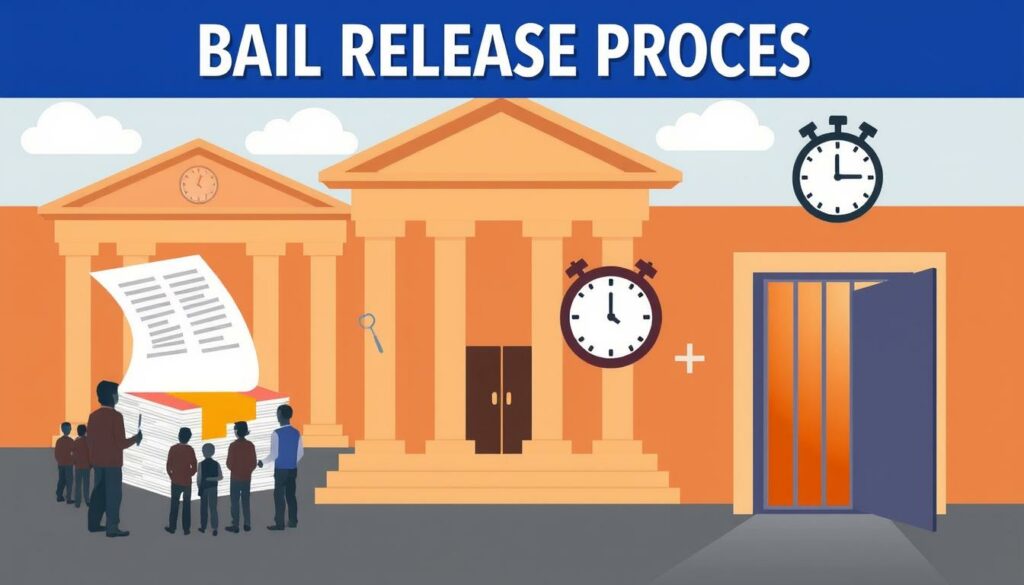
27 Jan How Long After Bail Is Posted Are You Released?
When bail is posted, the clock starts ticking on the release process. The time it takes to get released can vary a lot. Many people wonder about the bail process time and how long it takes to get out.
After posting bail, a complex coordination begins between the jail and court system. This process involves verifying bail payment, processing paperwork, and preparing for release. Each step in this journey affects the overall bail release time.
The time it takes can range from a few hours to several days. Things like jail population, staff availability, and how efficient the system is all matter. Remember, patience is key during this waiting period. Armstrong Bail Bonds can help guide you on the process.
Key Takeaways
- Bail release time varies based on multiple factors
- Coordination between jail and court system is essential
- Verification of bail payment is a critical step
- Jail population and staff availability affect processing speed
- Release can take anywhere from hours to days
- Patience is important during the waiting period
Understanding the Initial Bail Posting Process
The bail posting process has several key steps that can affect how long it takes to get released. After a bail decision, the first steps are filling out paperwork and checking the payment.
Paperwork Submission and Processing
Bail bond agents are important in making the release process faster. They fill out all needed documents and send them to the court or jail. This is the first step in starting the official release process.
Payment Verification Steps
After the documents are sent, the court or jail checks the payment. They make sure the money is safe and recorded correctly. How fast this step goes can really impact how long it takes to make a bail decision.
Court Notification Systems
After the payment is checked, the jail gets an update. This update starts the next part of getting ready for release. Good court notification systems can make the bail hearing shorter and the release time faster.
| Process Step | Responsible Party | Estimated Duration |
|---|---|---|
| Paperwork Submission | Bail Bond Agent | 1-2 hours |
| Payment Verification | Court/Jail | 2-4 hours |
| Court Notification | Jail Administration | 1-3 hours |
Knowing these first steps helps set realistic expectations for the bail release process. How well each step is done affects the total time from posting bail to being released.
Typical Bail Release Time and Processing Duration
The time it takes to get out on bail can vary a lot. Some people might get out in 30 minutes, while others wait up to 24 hours. This unpredictability can be frustrating for those waiting to be free.
Several things can affect how long it takes to get released. These include:
- Jail occupancy and workload
- Staff availability
- Complexity of the case
- Time of day or night
Remember, quick action can help you get out faster. The sooner you or your loved ones get a bail bond, the sooner things start moving. Paying quickly can also speed up the process, saving you hours.
It’s good to have realistic hopes for a quick release. The bail process involves many steps and checks. Being patient is important, as rushing can cause delays.
| Release Scenario | Estimated Time |
|---|---|
| Best Case | 30 minutes – 2 hours |
| Average Case | 4 – 8 hours |
| Worst Case | 12 – 24 hours |
Keep in mind, these times are just estimates. They can change based on many factors. Stay updated and talk often with your bail bondsman for the latest on your situation.
Factors Affecting Release Timeline
The speed of bail release can vary a lot. Knowing what affects it helps us understand how long it might take.
Jail Population and Traffic
A crowded jail makes things slower. With more inmates, it takes longer to process everyone. Expect longer waits during busy times.
Staff Availability and Shifts
How many staff are working and when they work matters. Night releases might be slower because of fewer staff. Try to post bail when staff is most available.
Administrative Processing Speed
How well a jail handles paperwork also matters. Some use new systems to speed things up. Others might be slower because of old methods.
Outstanding Warrants Check
Checking for outstanding warrants is a must before release. This step is important for safety. If there are issues, it can take longer. Clear records usually mean quicker releases.
| Factor | Impact on Release Speed |
|---|---|
| High Jail Population | Significant delay |
| Full Staff During Day Shift | Faster processing |
| Efficient Administrative Systems | Quicker release |
| Complex Warrant Checks | Potential extended wait |
The Booking and Processing Stage
The booking and processing stage is key in the court bail release timing. It lays the groundwork for a quick bail release. It also plays a big role in getting fast bail bond approval.

Fingerprinting and Photography
When you arrive, you’ll get fingerprinted and have your mugshot taken. These steps help identify you and keep records. How fast this goes can really affect how soon you get out.
Background Check Procedures
A detailed background check is done to confirm who you are and if you have any warrants. This is important for safety and the bail system’s integrity. The speed of this check can impact how quickly you get bail.
Initial Paperwork Requirements
You’ll need to fill out some basic forms. These ask for your name, address, and birthdate. This info is important for processing and can speed up your release. Quick and accurate form filling helps a lot.
| Process Step | Estimated Time | Impact on Release |
|---|---|---|
| Fingerprinting | 15-30 minutes | Moderate |
| Photography | 5-10 minutes | Low |
| Background Check | 30-60 minutes | High |
| Paperwork | 20-40 minutes | Moderate |
Knowing these steps can help you move through the booking process faster. This could lead to a quicker release time overall.
Release Preparation After Bail Acceptance
After bail is accepted, jail officials start a detailed process for a quick release. They check the bail documents, confirm the person’s identity, and match it with court orders. The time it takes can change based on the jail’s rules and how busy they are.
Jail staff look over all the paperwork to make sure it’s right. They check the person’s identity with fingerprints and ID photos. This step is key to avoid mistakes that could cause wrong releases or delays.
They also check the court orders against the bail documents. This makes sure the bail amount, any special rules, and no other warrants or holds are there. It’s important to follow all legal steps.
How fast this process goes can really affect how soon someone gets out. Some jails use digital systems to make these checks faster. Others might do it the old-fashioned way, which takes longer.
- Review of bail documentation
- Identity confirmation procedures
- Cross-referencing of court orders
- Verification of bail amount and conditions
- Check for outstanding warrants or holds
Knowing about these steps can help people plan for their release. Even though the goal is to get them out fast, being thorough is key to keeping the justice system fair.
Documentation and Property Return Process
The final stage of the bail release time involves important steps. These steps help you smoothly return to freedom. Knowing them is key to understanding how long it takes to get released on bail.
Personal Belongings Collection
After bail is posted, the jail staff gets your personal items ready for you. This includes clothes, wallet, keys, and other things taken during booking. The time it takes to get released might be longer if there are many releases or if items are in different places.
Release Documentation Review
You’ll get papers with important details about your release. These papers list court dates, bail terms, and any rules you must follow. It’s vital to read each form carefully to avoid legal problems. This step is important but can add to the time it takes to get released.
Final Security Clearance
A final security check is done before you leave. This check makes sure you meet all legal requirements. It includes verifying your identity and checking for any outstanding warrants. While it’s necessary, this step can slightly delay your release.
| Process Step | Estimated Time | Potential Delays |
|---|---|---|
| Property Return | 15-30 minutes | High release volume, misplaced items |
| Document Review | 10-20 minutes | Complex release conditions, paperwork errors |
| Security Clearance | 5-15 minutes | System issues, warrant checks |

Knowing these steps can help you understand the bail release time better. The process is designed to be quick, but different factors can affect the total time from posting bail to leaving the jail.
Legal Requirements Before Release
Before someone can be released on bail, several legal steps must be taken. These steps help keep the justice system fair. They can also affect how long it takes to get out of jail.
Warrant Verification
Jail staff carefully check for any outstanding warrants. This step can make the bail process longer. It’s because they need to make sure no other places have charges against the defendant.
The time it takes depends on the case’s complexity and the databases searched.
Court Order Confirmation
Confirming court orders is key before release. Staff must check all documents are correct and the bail amount is right. This can affect how long it takes to process the bail.
Courts have different ways to confirm orders. This can vary by place.
Bail Conditions Review
The last step is reviewing bail conditions. These might include travel limits, check-ins, or electronic monitoring. It’s important to understand and document these conditions.
This ensures everyone follows the rules. It can also impact how long it takes to be released.
Being ready for these legal steps can help speed up release. But, the time it takes can vary a lot. This depends on the case and the jail’s resources.
Post-Release Obligations and Responsibilities
After you’re released on bail, you must know your responsibilities. The bail release time is when you start following court rules closely.
- Attend all court appearances
- Comply with travel restrictions
- Check in regularly with bail bondsmen or law enforcement
- Adhere to any specific conditions set by the court
Not following these rules can cause big problems. You could lose your bail and face more legal issues. It’s important to remember that the bail approval timeframe is just the beginning of your duties.
To handle these duties well, think about:
- Creating a calendar with all important dates and check-ins
- Setting reminders for court appearances
- Staying in regular contact with your bail bondsman
- Seeking legal advice if you’re unsure about any conditions
The bail bond release time starts a time when you must be very responsible. By following all rules carefully, you can get through this successfully and avoid more legal trouble.
| Obligation | Frequency | Importance |
|---|---|---|
| Court Appearances | As scheduled | Critical |
| Bail Bondsman Check-ins | Weekly/Monthly | High |
| Travel Restriction Compliance | Continuous | Essential |
| Condition Reviews | Periodic | Important |
Conclusion
The time it takes to get out of jail after bail can vary a lot. Knowing the steps in the bail release process helps set realistic expectations. Each step, from posting bail to being released, is important for the speed of bail release.
How fast someone gets out depends on jail population, staff, and how well things run. The bail hearing schedule also plays a part. Remember, the slow pace is to keep everyone safe and follow the law.
Being patient is essential when dealing with bail. Having all the right info and documents ready can speed things up. After release, following all rules is key. This helps avoid problems that could lead to being arrested again or having bail revoked.
Understanding the bail process helps people deal with it better. Whether using cash bail or a bail bond agent, knowing what to expect is important. It helps everyone make better choices and have realistic hopes about when they’ll be released. Call Armstrong Bail Bonds today and received all the help you need!!

